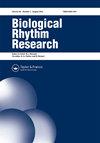光周期通过Nrf2-Keap1信号通路影响barabensis肝脏氧化应激
IF 0.9
4区 生物学
Q3 BIOLOGY
引用次数: 0
摘要
本文章由计算机程序翻译,如有差异,请以英文原文为准。
Photoperiod affects oxidative stress in the liver of Cricetulus barabensis through the Nrf2-Keap1 signaling pathway
ABSTRACT Changes in photoperiod affect both oxidative stress (OS) levels and antioxidant enzyme activities in animals. The liver accounts for a vital body metabolic organ. Different light durations may produce different outcomes in terms of OS and liver antioxidant pathways, but the underlying mechanism is not yet understood. This study investigated the effects of diverse photoperiods (SD, short day; MD, moderate day; LD, long day) on OS degree (H2O2 and MDA), antioxidant enzyme activities (superoxide dismutase [SOD], catalase [CAT], and glutathione peroxidase [GPx]), liver total antioxidant capacity, and the Nrf2-Keap1 signaling pathway in striped dwarf hamsters (Cricetulus barabensis) livers. Our results showed that (1) SD treatment for 8 weeks increased the levels of phosphorylated Nrf2, upregulated the Nrf2-Keap1 signaling pathway, and increased the protein expression of SOD and GPx, while decreasing the MDA concentration, all of which reduced the OS degree. (2) Additionally, LD treatment for 8 weeks reduced the extent of Nrf2 phosphorylation, resulting in downregulation of the Nrf2-Keap1 pathway, thus reducing protein expression of SOD2 and CAT, increasing the concentrations of H2O2 and MDA, and increasing OS degree. Collectively, OS levels in C. barabensis liver decreased during SD but increased during LD.
求助全文
通过发布文献求助,成功后即可免费获取论文全文。
去求助
来源期刊

Biological Rhythm Research
生物-生理学
CiteScore
3.00
自引率
9.10%
发文量
34
审稿时长
6-12 weeks
期刊介绍:
The principal aim of Biological Rhythm Research is to cover any aspect of research into the broad topic of biological rhythms. The area covered can range from studies at the genetic or molecular level to those of behavioural or clinical topics. It can also include ultradian, circadian, infradian or annual rhythms. In this way, the Editorial Board tries to stimulate interdisciplinary rhythm research. Such an aim reflects not only the similarity of the methods used in different fields of chronobiology, but also the fact that many influences that exert controlling or masking effects are common. Amongst the controlling factors, attention is paid to the effects of climate change on living organisms. So, papers dealing with biometeorological aspects can also be submitted.
The Journal publishes original scientific research papers, review papers, short notes on research in progress, book reviews and summaries of activities, symposia and congresses of national and international organizations dealing with rhythmic phenomena.
 求助内容:
求助内容: 应助结果提醒方式:
应助结果提醒方式:


